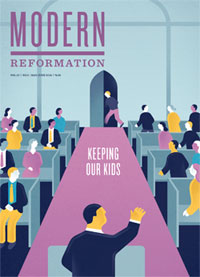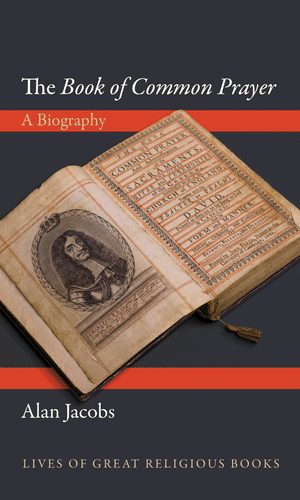
I was honored a few months ago to be asked to review Alan Jacobs’ new biography of The Book of Common Prayer for Modern Reformation magazine, one of my/our favorite periodicals. Seeing as the issue in which it appears just hit stands (May-June), here’s a generous portion of the article. Be sure to head over to Mod Ref and subscribe to read the whole thing:
 To borrow a phrase from faux fashion icon Mugatu in Ben Stiller’s film Zoolander, liturgy is so hot right now. A minister at an evangelical Congregational church in Massachusetts uses The Book of Common Prayer at every baptism. In Texas, at an emergent congregation with Baptist roots, the praise music ends and they celebrate the Eucharist with actual wine. Up on the screen, the skinny-jeans-clad pastor is called “Celebrant.” A former megachurch member says of her joining the Episcopal Church: “I was looking for a connection with the ancient church; you know, something that doesn’t change every week.” It’s no wonder then, that in our live-tweeting-everything world, the seemingly unchanging liturgy draws people. But as Alan Jacob’s ode, The Book of Common Prayer: A Biography
To borrow a phrase from faux fashion icon Mugatu in Ben Stiller’s film Zoolander, liturgy is so hot right now. A minister at an evangelical Congregational church in Massachusetts uses The Book of Common Prayer at every baptism. In Texas, at an emergent congregation with Baptist roots, the praise music ends and they celebrate the Eucharist with actual wine. Up on the screen, the skinny-jeans-clad pastor is called “Celebrant.” A former megachurch member says of her joining the Episcopal Church: “I was looking for a connection with the ancient church; you know, something that doesn’t change every week.” It’s no wonder then, that in our live-tweeting-everything world, the seemingly unchanging liturgy draws people. But as Alan Jacob’s ode, The Book of Common Prayer: A Biography (Princeton), teaches us, liturgy in general and Anglican liturgy in particular, is surprisingly contingent, fluctuating, and malleable…
In his book, Jacobs walks us, briskly, through the BCP’s history. We see [Thomas] Cranmer replace a perplexing constellation of Roman rites (in Latin, of course) with one in English, uniting the realm (whether they liked it or not). Cranmer’s liturgy hummed with scripture and was infused with the doctrine of justification by faith. At the same time, Cranmer sought to maintain the catholicity and sacramental worship of the English church. There was some compromise baked in from the beginning. In spite of this, and not without plenty of controversy (Cranmer was martyred), the Prayer Book took hold. Ultimately, as England’s empire grew, so spread its form of worship. The 1662 BCP is the ancestor of Prayer Books used from Malawi to Singapore to that other former colony, the United States.
As an introduction to the BCP, Jacobs’ accomplishment is without parallel… We read how Cranmer (a married man) added the then-novel and very touching phrase “to love and to cherish” to the wedding vows. We read how in the Edinburgh cathedral in 1637, Jenny Geddes hurled a stool at the minister when he began the Communion prayers. His crime: using a version Geddes deplored. (The next minister kept two loaded pistols on his prayer desk.) We read of the great controversy over kneeling and how evangelicals ripped out and burned the altar rails. We hear of nineteenth-century Anglo-Catholic priests flaunting rubrics with extra candles on the altar—for which they willingly went to jail. And in one of the book’s many laugh-out-loud moments, we read of W. H. Auden, who after learning of his Rector’s liturgical innovations, wrote to ask the clergyman if he had gone “stark raving mad.”…
 In Jacobs’ hands, we see the BCP as a text that has weathered “the sundry and manifold changes of the world” (Collect for the Fourth Sunday of Easter, The Book of Common Prayer). It has been edited, revised, authorized but not printed, printed but not authorized, burned, banned, and neglected. Much of its original form came from the life and mind of one man. And the convictions and circumstances of men and women since have shaped the book’s fate and form. It is a human book bearing the stamp of many a human life. And it has made its own stamp on so many lives since.
In Jacobs’ hands, we see the BCP as a text that has weathered “the sundry and manifold changes of the world” (Collect for the Fourth Sunday of Easter, The Book of Common Prayer). It has been edited, revised, authorized but not printed, printed but not authorized, burned, banned, and neglected. Much of its original form came from the life and mind of one man. And the convictions and circumstances of men and women since have shaped the book’s fate and form. It is a human book bearing the stamp of many a human life. And it has made its own stamp on so many lives since.
Ultimately, the BCP reflects an incarnational reality. With the word “Incarnation,” Christians name that aspect of God’s character in which God is pleased to intimately involve himself with us volatile beings of highly diluted virtue. In fact, it pleases him so much that he is “born of the Virgin Mary and made man.”
What a fitting thing, then, for such a faith to have produced a Book of Common Prayer. A book so venerated and revered, so malleable and bent; smudged with the fingerprints of the countless sinners and saints who have found such comfort in its pages. And we are indebted to Jacobs for bringing to light again this treasure for the next generation of men and women who need the book’s Comfortable Words.

COMMENTS
Leave a Reply












